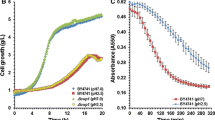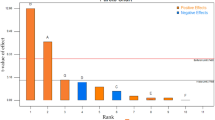Abstract
High hydrostatic pressure (HHP) is a stress that exerts broad effects on microorganisms with characteristics similar to those of common environmental stresses. In this study, we aimed to identify genetic mechanisms that can enhance alcoholic fermentation of wild Saccharomyces cerevisiae isolated from Brazilian spirit fermentation vats. Accordingly, we performed a time course microarray analysis on a S. cerevisiae strain submitted to mild sublethal pressure treatment of 50 MPa for 30 min at room temperature, followed by incubation for 5, 10 and 15 min without pressure treatment. The obtained transcriptional profiles demonstrate the importance of post-pressurisation period on the activation of several genes related to cell recovery and stress tolerance. Based on these results, we over-expressed genes strongly induced by HHP in the same wild yeast strain and identified genes, particularly SYM1, whose over-expression results in enhanced ethanol production and stress tolerance upon fermentation. The present study validates the use of HHP as a biotechnological tool for the fermentative industries.






Similar content being viewed by others
References
Aertsen A, De Spiegeleer P, Vanoirbeek K, Lavilla M, Michiels CW (2004) Induction of oxidative stress by high hydrostatic pressure in Escherichia coli. Appl Environ Microbiol 71:2226–2231. doi:10.1128/AEM.71.5.2226-2231.2005
Aldsworth TG, Sharman RL, Dodd CER (1999) Bacterial suicide through stress. Cell Mol Life Sci 56:378–383. doi:10.1007/s000180050439
Bakker BM, Overkamp KM, van Maris AJ, Kötter P, Luttik MA, van Dijken JP, Pronk JT (2001) Stoichiometry and compartmentation of NADH metabolism in Saccharomyces cerevisiae. FEMS Microbiol Rev 25:15–37
Bandara A, Fraser S, Chambers PJ, Stanley GA (2009) Trehalose promotes the survival of Saccharomyces cerevisiae during lethal ethanol stress, but does not influence growth under sublethal ethanol stress. FEMS Yeast Res 9:1208–1216. doi:10.1111/j.1567-1364.2009.00569.x
Bravim F, Palhano FL, Fernandes AA, Fernandes PM (2010) Biotechnological properties of distillery and laboratory yeasts in response to industrial stresses. J Ind Microbiol Biotechnol 37:1071–1079. doi:10.1007/s10295-010-0755-0
Cao L, Kong Q, Zhang A, Chen X (2010) Overexpression of SYM1 in a gpdDelta mutant of Saccharomyces cerevisiae with modified ammonium assimilation for optimization of ethanol production. J Taiwan Inst Chem Eng 41:2–7. doi:10.1016/j.jtice.2009.04.012
Causton HC, Ren B, Koh SS, Harbison CT, Kanin E, Jennings EG, Lee TI, True HL, Lander ES, Young RA (2001) Remodeling of yeast genome expression in response to environmental changes. Mol Biol Cell 12:323–337
Coleman ST, Fang TK, Rovinsky SA, Turano FJ, Moye-Rowley WS (2001) Expression of a glutamate decarboxylase homologue is required for normal oxidative stress tolerance in Saccharomyces cerevisiae. J Biol Chem 276:244–2450. doi:10.1074/jbc.M007103200
Estruch F (2000) Stress-controlled transcription factors, stress-induced genes and stress tolerance in budding yeast. FEMS Microbiol Rev 24:469–486. doi:10.1111/j.1574-6976.2000.tb00551.x
Fernandes PMB (2005) How does yeast respond to pressure? Braz J Med Biol Res 38:1239–1245, ISSN 1414-431X
Fernandes PMB (2008) Saccharomyces cerevisiae response to high hydrostatic pressure. In: Michiels C, Bartlett DH, Aertsen A (eds) High-pressure microbiology. American Society of Microbiology, Washington, pp 145–166
Fernandes PM, Panek AD, Kurtenbach E (1997) Effects of hydrostatic pressure on a mutant of Saccharomyces cerevisiae deleted in trehalose-6-phosphate synthase gene. FEMS Microbiol Lett 152:17–21. doi:10.1111/j.1574-6968
Fernandes PM, Farina M, Kurtenbach E (2001) Effect of hydrostatic pressure on the morphology and ultrastructure of wild-type and trehalose synthase mutant cells of Saccharomyces cerevisiae. Lett Appl Microbiol 32:42–46. doi:10.1111/j.1472-765X.2001.00853.x
Fernandes PMB, Domitrovic T, Kao CM, Kurtenbach E (2004) Genome expression pattern in Saccharomyces cerevisiae cells in response to high hydrostatic pressure. FEBS Lett 556:153–160. doi:10.1016/S0014-5793(03)01396-6
Gasch AP (2003) The environmental stress response: a common yeast response to diverse environmental stresses. In: Hohmann S, Mager WH (eds) Yeast stress response, 2nd edn. Springer, Berlin, pp 11–70
Gasch AP, Spellman PT, Kao CM, Carmel-Harel O, Eisen MB, Storz G, Botstein D, Brown PO (2000) Genomic expression programs in the response of yeast cells to environmental changes. Mol Biol Cell 11:4241–4257
Gietz RD, Schiestl RH (2007) High-efficiency yeast transformation using the LiAc/SS carrier DNA/PEG method. Nat Protoc 2:31–34. doi:10.1038/nprot.2007.13
Hahn JS, Neef DW, Thiele DJ (2006) A stress regulatory network for co-ordinated activation of proteasome expression mediated by yeast heat shock transcription factor. Mol Microbiol 60:240–251. doi:10.1111/j.1365-2958.2006.05097.x
Hanlon SE, Rizzo JM, Tatome DC, Lieb JD, Buck MJ (2011) The stress response factors Yap6, Cin5, Phd1, and Skn7 direct targeting of the conserved co-repressor Tup1-Ssn6 in S. cerevisiae. PLoS One 6:e19060. doi:10.1371/journal.pone.0019060
Hoshi T, Heinemann S (2001) Regulation of cell function by methionine oxidation and reduction. J Physiol 531:1–11. doi:10.1111/j.1469-7793.2001.0001j.x
Igual JC, Estruch F (2000) Signalling stress in yeast. Food Technol Biotechnol 38:263–276
Iwahashi H, Nwaka S, Obuchi K (2000) Evidence for contribution of neutral trehalase in barotolerance of Saccharomyces cerevisiae. Appl Environ Microbiol 66:5182–5185
Iwahashi H, Shimizu H, Odani M, Komatsu Y (2003) Piezophysiology of genome wide gene expression levels in the yeast Saccharomyces cerevisiae. Extremophiles 7:291–298. doi:10.1007/s00792-003-0322-y
Iwahashi H, Odani M, Ishidou E, Kitagawa E (2005) Adaptation of Saccharomyces cerevisiae to high hydrostatic pressure causing growth inhibition. FEBS Lett 579:2847–2852. doi:10.1016/j.febslet.2005.03.100
Lippman SI, Broach JR (2009) Protein kinase A and TORC1 activate genes for ribosomal biogenesis by inactivating repressors encoded by Dot6 and its homolog Tod6. Proc Natl Acad Sci U S A106:19928–19933. doi:10.1073/pnas.0907027106
Livak KJ, Schmittgen TD (2001) Analysis of relative gene expression data using real-time quantitative PCR and the 2−ΔΔCT method. Methods 25:402–408. doi:10.1006/meth.2001.1262
Luo S, Levine RL (2009) Methionine in proteins defends against oxidative stress. FASEB J 23:464–472. doi:10.1096/fj.08-118414
Mai B, Breeden L (1997) Xbp1, a stress-induced transcriptional repressor of the Saccharomyces cerevisiae Swi4/Mbp1 family. Mol Cell Biol 17:6491–6501
Maiti B, Rathore A, Srivastava S, Shekhawat M, Srivastava P (2011) Optimization of process parameters for ethanol production from sugar cane molasses by Zymomonas mobilis using response surface methodology and genetic algorithm. Appl Microbiol Biotechnol 90:385–395. doi:10.1007/s00253-011-3158-x
MIDIC (2010) Ministério do Desenvolvimento, Indústria e Comércio Exterior. http://www.mdic.gov.br/sitio/. Assessed 16 Sept
Motshwene P, Karreman R, Kgari G, Brandt W, Lindsey G (2004) LEA (late embryonic abundant)-like protein Hsp 12 (heat-shock protein 12) is present in the cell wall and enhances the barotolerance of the yeast Saccharomyces cerevisiae. Biochem J 377:769–774. doi:10.1042/BJ20031301
Murata Y, Watanabe T, Sato M, Momose Y, Nakahara T, Oka S, Iwahashi H (2003) Dimethyl sulfoxide exposure facilitates phospholipid biosynthesis and cellular membrane proliferation in yeast cells. J Biol Chem 278:33185–33193. doi:10.1074/jbc.M300450200
Oliveira ES, Cardello HMAB, Jeronimo EM, Souza ELR, Serra GE (2005) The influence of different yeasts on the fermentation, composition and sensory quality of cachaça. World J Microb Biot 21:707–715. doi:10.1007/s11274-004-4490-4
Omura F, Hatanaka H, Nakao Y (2007) Characterization of a novel tyrosine permease of lager brewing yeast shared by Saccharomyces cerevisiae strain RM11-1a. FEMS Yeast Res 7:1350–1361. doi:10.1111/j.1567-1364.2007.00310.x
Palhano FL, Gomes HL, Orlando MT, Kurtenbach E, Fernandes PM (2004a) Pressure response in the yeast Saccharomyces cerevisiae: from cellular to molecular approaches. Cell Mol Biol 50:447–457. doi:10.1170/T533
Palhano FL, Orlando MT, Fernandes PM (2004b) Induction of baroresistance by hydrogen peroxide, ethanol and cold-shock in Saccharomyces cerevisiae. FEMS Microbiol Lett 233:139–145. doi:10.1016/j.femsle.2004.02.002
Parrou JL, Teste MA, François J (1997) Effects of various types of stress on the metabolism of reserve carbohydrates in Saccharomyces cerevisiae: genetic evidence for a stress-induced recycling of glycogen and trehalose. Microbiology 143:1891–1900. doi:10.1099/00221287-143-6-1891
Pataro C, Guerra JB, Petrillo-Peixoto ML, Mendonça-Hagler LC, Linardi VR, Rosa CA (2000) Yeast communities and genetic polymorphism of Saccharomyces cerevisiae strains associated with artisanal fermentation in Brazil. J App Microbiol 89:24–31. doi:10.1046/j.1365-2672.2000.01092.x
Sahara T, Goda T, Ohgiya S (2002) Comprehensive expression analysis of time-dependent genetic responses in yeast cells to low temperature. J Biol Chem 277:50015–50021. doi:10.1074/jbc.M209258200
Schöneich C (2005) Methionine oxidation by reactive oxygen species: reaction mechanisms and relevance to Alzheimer’s disease. Biochim Biophys Acta 1703:111–119. doi:10.1016/j.bbapap. 2004.09.009
Schuller D, Casal M (2005) The use of genetically modified Saccharomyces cerevisiae strains in the wine industry. Appl Microbiol Biotechnol 68:292–304. doi:10.1007/s00253-005-1994-2
Schwan RF, Mendonça AT, da Silva JJ Jr, Rodrigues V, Wheals AE (2001) Microbiology and physiology of cachaça (Aguardente) fermentations. Antonie van Leeuwenhoek 79:89–96. doi:10.1023/A:1010225117654
Silva CLC, Vianna CR, Cadete RM, Santos RO, Gomes FC, Oliveira ES, Rosa CA (2009) Selection, growth, and chemo-sensory evaluation of flocculent starter culture strains of Saccharomyces cerevisiae in the large-scale production of traditional Brazilian cachaça. Int J Food Microbiol 131:203–210. doi:10.1016/j.ijfoodmicro.2009.02.027
Singer MA, Lindquist S (1998) Thermotolerance in Saccharomyces cerevisiae: the yin and yang of trehalose. Trends Biotechnol 16:460–468. doi:10.1016/S0167-7799(98)01251-7
Teixeira MC, Mira NP, Sá-Correia I (2011) A genome-wide perspective on the response and tolerance to food-relevant stresses in Saccharomyces cerevisiae. Curr Opin Biotechnol 22:150–156. doi:10.1016/j.copbio.2010.10.011
Teste MA, Duquenne M, François JM, Parrou JL (2009) Validation of reference genes for quantitative expression analysis by real-time RT-PCR in Saccharomyces cerevisiae. BMC Mol Biol 10:99–114. doi:10.1186/1471-2199-10-99
Tfouni SAV, Machado RMD, Camargo MCR, Vitorino SHP, Vicente E, Toledo MCF (2007) Determination of polycyclic aromatic hydrocarbons in cachaça by HPLC with fluorescence detection. Food Chem 101:334–338. doi:10.1016/j.foodchem.2006.01.040
Trejo-Pech CO, López-Reyna MC, House LA, Messina W (2010) Appellation of origin status and economic development: a case study of the Mezcal industry. Int Food Agrib Man Rev 13:117–136
Trott A, Morano KA (2004) SYM1 is the stress-induced Saccharomyces cerevisiae ortholog of the mammalian kidney disease gene Mpv17 and is required for ethanol metabolism and tolerance during heat shock. Eukaryot Cell 3:620–631. doi:10.1128/EC.3.3.620-631.2004
Vicente MA, Fietto LG, Castro IM, dos Santos AN, Coutrim MX, Brandão RL (2006) Isolation of Saccharomyces cerevisiae strains producing higher levels of flavoring compounds for production of “cachaça” the Brazilian sugarcane spirit. Int J Food Microbiol 108:51–59. doi:10.1128/AEM.01729-07
Weissbach H, Etienne F, Hoshi T, Heinemann SH, Lowther WT, Matthews B, St John G, Nathan C, Brot N (2002) Peptide methionine sulfoxide reductase: structure, mechanism of action, and biological function. Arch Biochem Biophys 397:172–178. doi:10.1006/abbi.2001.2664
Welker S, Rudolph B, Frenzel E, Hagn F, Liebisch G, Schmitz G, Scheuring J, Kerth A, Blume A, Weinkauf S, Haslbeck M, Kessler H, Buchner J (2010) Hsp12 is an intrinsically unstructured stress protein that folds upon membrane association and modulates membrane function. Mol Cell 39:507–520. doi:10.1016/j.molcel.2010.08.001
World Health Organization—WHO 2004. WHO global status report on alcohol 2004. Available from http://www.who.int/substance_abuse/publications/global_status_report_2004_overview.pdf. Assessed 07 Nov 2011
Yale J, Bohnert HJ (2001) Transcript expression in Saccharomyces cerevisiae at high salinity. J Biol Chem 276:15996–16007. doi:10.1074/jbc.M008209200
Zaman S, Lippman SI, Schneper L, Slonim N, Broach JR (2009) Glucose regulates transcription in yeast through a network of signaling pathways. Mol Syst Biol 5:245. doi:10.1038/msb.2009.2
Acknowledgements
This work was supported by grants from Financiadora de Estudos e Projetos, Conselho Nacional de Desenvolvimento Científico e Tecnológico and Fundação de Amparo à Pesquisa do Estado do Espírito Santo.
Author information
Authors and Affiliations
Corresponding author
Electronic supplementary material
Below is the link to the electronic supplementary material.
ESM 1
(PDF 473 kb)
Rights and permissions
About this article
Cite this article
Bravim, F., Lippman, S.I., da Silva, L.F. et al. High hydrostatic pressure activates gene expression that leads to ethanol production enhancement in a Saccharomyces cerevisiae distillery strain. Appl Microbiol Biotechnol 97, 2093–2107 (2013). https://doi.org/10.1007/s00253-012-4356-x
Received:
Revised:
Accepted:
Published:
Issue Date:
DOI: https://doi.org/10.1007/s00253-012-4356-x




